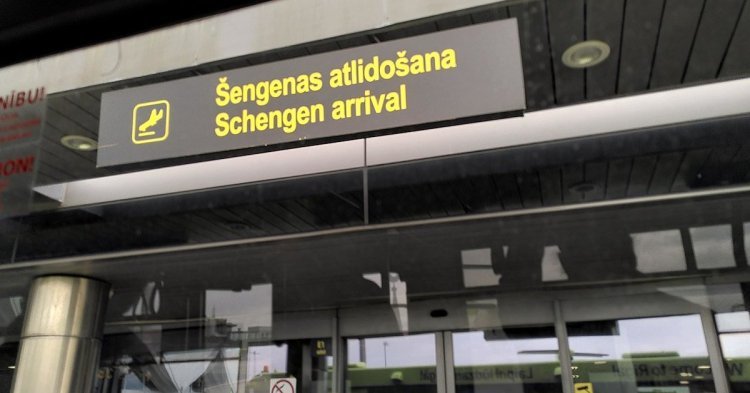The Schengen Area, often hailed as the long-sought “Europe without borders” dream, has been a prominent vision since the early 20th century when Count Richard Coudenhove-Kalergi (1894-1972), a pan-Europeanist visionary, first proposed such an endeavour in his 1923 manifesto, “Pan-Europa.” This monumental project will commemorate its 30th anniversary in about a year, or 40th if we consider the time since the signing of the agreement that led to its establishment.
For those born in the last 30 years, the idea of a borderless Europe is often associated with the European Union (EU).
Nevertheless, it’s crucial to acknowledge that not too long ago, the European Union’s two leading countries, France and Germany, were former adversaries with a history of frequent conflicts. During that period, they shared an extensive border for the movement of both people and goods. The historical context is significant, with various EU member states having a long history of conflict and wars spanning centuries. Despite this complex history, the Schengen Area has played a pivotal role in fostering unity and collaboration, symbolising a departure from the historical enmities among European nations. At present, the Schengen Agreement encompasses 27 countries, comprising approximately 420 million citizens who can freely travel within the bloc without encountering border controls.
Nevertheless, the pan-European dreamland has not been all sunshine and joy in recent years.
The Dream
The Schengen Agreement, initially signed in 1985 by five Western European countries, underwent a gradual expansion to include new members across the continent until its implementation in 1995. By 1997, all EU Member States, except the United Kingdom (UK) and Ireland, had eliminated their borders with neighbouring countries. In that same year, the Schengen Agreement officially became an organ of the EU when it was incorporated as the Schengen acquis within the Treaty of Amsterdam, allowing countries to opt-out if they chose to do so. In essence, the realisation of a borderless Europe through the Schengen Area embodied the founders’ dream of establishing a means to facilitate efficient economic cooperation and mutual interdependence among European nations, thereby reducing the likelihood of future conflicts. Evidently, since the establishment of these frameworks, there has been no war between any EU Member State or Schengen Members. However, the seamless cooperation among countries within this intergovernmental framework experiences both positive and challenging phases.
Pins and Needles
Ironically, the number 27, representing both the current EU member countries and the Schengen Agreement participants, exhibits a mismatching set of countries. Presently, four non-EU Member States—Norway, Iceland, Switzerland, and Liechtenstein—are part of the Schengen Area. Additionally, certain European microstates, namely the Vatican and San Marino, which are landlocked in within Italy actively participate in the borderless project by forgoing active border controls with their neighbours. Andorra, situated landlocked between France and Spain, actively engages in the open border arrangement as well. However, it chose to retain the authority to conduct border checks on its boundaries with these two countries. The significant differences in membership between the two organisations are evident. While Schengen incorporates four non-EU countries, it excludes four existing EU Member States—Romania, Bulgaria, Cyprus, and Ireland, as of December 2023. The question that arises is “why”. Upon joining the European Union, a country expresses its willingness to join the Schengen Area as part of the Schengen acquis. However, reality demonstrates that this commitment does not automatically translate into participation. In brief, Ireland and Cyprus face longstanding internal border issues preventing their inclusion. Ireland cites the existence of the “Common Travel Area” (CTA) with the UK as the reason for its reluctance to join Schengen. The CTA permits Ireland and Northern Ireland to forego a physical border, and joining Schengen would necessitate the establishment of a border between them. While some discussions in Ireland have entertained the possibility of joining the Schengen Agreement if the UK enforces a border between the two Irelands (a prospect almost realised after Brexit), this option is currently off the table, and Ireland retains the right to opt out of Schengen. Cyprus, on the other hand, previously applied to join Schengen but was rejected, despite meeting requirements related to personal data protection. The ongoing border dispute, with part of its territory claimed by North Cyprus, recognised only by Turkey, further hinders Cyprus’s Schengen prospects. Additionally, the presence of two British military bases on the island adds complexity. Despite these challenges, there is a positive development, as in 2023, Cyprus gained official access to the Schengen Area’s Information System (SIS), signalling a step toward potential future inclusion.
The two remaining EU Member States yet to be part of the Schengen Agreement are Romania and Bulgaria, and their situations have sparked significant divisions within the EU. Despite both countries joining the European Union in 2007, they have not been allowed to officially join the shared-visa bloc. In 2011, after fulfilling all necessary criteria and gaining approval from the European Parliament, their bid faced rejection in the Council of Ministers. Foreign ministers from Belgium, the Netherlands, Sweden, Finland, and France, citing concerns over corruption, judicial reforms, and organised crime, opposed their accession. Despite subsequent improvements and repeated approval by the European Parliament, Romania and Bulgaria encountered persistent obstacles. In December 2022, Austria once again opposed the inclusion of both countries (with the Netherlands voting against Bulgaria only), alleging that their entry would compromise the effectiveness of Schengen border protection. This stance triggered a strong reaction in Romania, with calls for a boycott of Austrian businesses gaining traction on social media. The Romanian Prime Minister went as far as threatening to take Austria to the EU Court of Justice if they vetoed the countries once again in 2023, and additional diplomatic and financial measures against Austria were announced in case of a sustained veto. Despite these tensions, as the EU Justice and Home Affairs Council convened for the planned vote on allowing Romania and Bulgaria, Austria reiterated its veto. Consequently, the subject was entirely dropped from the meeting’s agenda, further exacerbating the ongoing discord surrounding the Schengen accession of Romania and Bulgaria.
What’s next?
The aspiration to join the Schengen Agreement has been a significant objective for both Romania and Bulgaria since 2007. Despite their efforts to meet the requirements set by other countries and EU institutions regarding border checks, organised crime, and corruption, the status of their bids remains uncertain. Nevertheless, the majority in the European Parliament consistently supports these endeavours, with Ursula von der Leyen, Roberta Metsola, and other European officials continually advocating for their accession. Questions arise regarding Austria’s persistent rejection of their entry. Speculations are ranging from serving Russian interests, which may be averse to Schengen expanding closer to its borders and potentially impacting Russian oil dependence, to the political landscape within Austria, including the growing success of the right-wing party “Freedom Party (FPÖ)” ahead of national elections. In response to Austria’s consistent criticism, there have been recent proposals suggesting the accession of Romania and Bulgaria solely in the context of air travel, while maintaining strict control over land crossings. Despite the complexities and uncertainties, there is a glimmer of hope that significant progress is underway. Optimism dictates that, in due course, all travel and trade restrictions will be lifted from both Romania and Bulgaria. The unity of the European Union remains fundamental and crucial for its future sustainability, as well as for our own who live on the European continent.


Follow the comments: |
|
